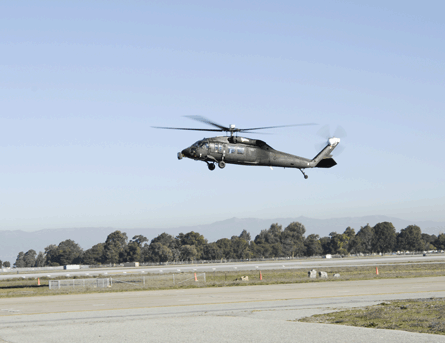A series of US Defense Advanced Research Projects Agency-funded tests in the California desert in early January could in the near future help helicopter pilots navigate through life-threatening brown-out conditions during take-off and landing, and not just on the battlefield.
Over three days and 32h of testing from 12-14 January, three US Army pilots with no previous flight time on the "Sandblaster" system were able to position their helicopters close to a landing on a variety of terrain types with no external visual references.
Having the ability to land in brownout conditions when helicopter downwash kicks up sand and drives visibility to zero has been a high priority for the US military in the Iraq and Afghanistan conflicts. Funded in May 2007, the $16.5 million Sandblaster programme called for Sikorsky and partners Honeywell and Sierra Nevada to demonstrate a system that could be used to help pilots guide a helicopter to a landing in such zero visibility conditions.
 |
|---|
© Honeywell |
The issue is not limited to military pilots operating overseas, however. On 22 February the pilot of a Eurocopter AS350B2 in Cave Creek, Arizona, experienced a brownout on night vision goggles when trying to land in a dirt parking lot next to an accident site at night. No one was injured when the helicopter landed hard, although the aircraft's tail boom and fuselage were structurally damaged.
During the Sandblaster final tests in January, the pilots of the Sikorsky JUH-60 Black Hawk, a highly modified platform used by NASA and the US Army for helicopter control law development, performed five approaches to three landing zones by referring to a compressed 30 x 30° field of view forward on a multifunction display.
Honeywell creates the scene by fusing 94GHz millimetre-wave radar data from a Sierra Nevada sand-penetrating radar system mounted on the nose of the helicopter with its proprietary 3D computer-rendered synthetic vision view using pre-stored terrain and obstacle data. The combination of the two technologies provides a comprehensive alternative to natural vision - synthetic vision for macro scene information radar for micro details and real-time elements not available in a terrain and obstacle database.
The test also took advantage of the JUH-60's fly-by-wire fully coupled control system, which features an automated hovering mode with little to no drift over a pre-programmed landing point.
Honeywell is to continue experimenting with the sensor fusion technologies, in part to help pilots detect and avoid cables and wires.
Source: Flight International























